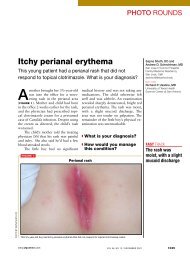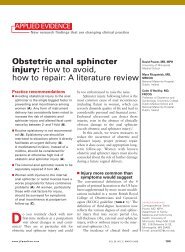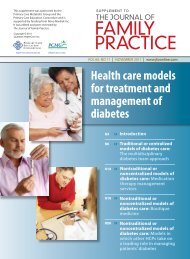Management of morbid obesity - The Journal of Family Practice
Management of morbid obesity - The Journal of Family Practice
Management of morbid obesity - The Journal of Family Practice
You also want an ePaper? Increase the reach of your titles
YUMPU automatically turns print PDFs into web optimized ePapers that Google loves.
in their normal-weight<br />
counterparts. 10,11 It has been<br />
calculated that for every<br />
kilogram <strong>of</strong> weight gained<br />
after high school, the risk<br />
<strong>of</strong> CAD increases by 5.7%<br />
in women and by 3.1% in<br />
men. 12 Data on the effects<br />
<strong>of</strong> bariatric surgery on the<br />
onset or progression <strong>of</strong><br />
CAD are lacking, and<br />
prospective cohort studies<br />
have failed to demonstrate<br />
a reduction in cardiovascular<br />
mortality when intentional<br />
weight loss is<br />
achieved nonsurgically. 26<br />
FIGURE 2<br />
Hypertension<br />
Men with class III <strong>obesity</strong><br />
are 1.7 to 4.6 times more<br />
likely to have hypertension than matched normal-weight<br />
controls. In <strong>morbid</strong>ly obese women, the risk increases by<br />
a factor <strong>of</strong> 1.4 to 5.5. 2,10<br />
As with diabetes, weight loss ameliorates hypertension.<br />
In obese patients, every 1-kg decrease in body<br />
weight is accompanied by an average decrease <strong>of</strong> 0.6<br />
mm Hg in systolic blood pressure and 0.34 mm Hg in<br />
diastolic pressure. 12 <strong>The</strong> beneficial effect <strong>of</strong> weight loss<br />
on blood pressure is consistently seen when weight loss<br />
is achieved through lifestyle modification; 27 however, it<br />
may not occur when weight loss is achieved with<br />
appetite-suppressing drugs. 6,12,28,29 Bariatric surgery is<br />
associated with complete resolution <strong>of</strong> hypertension in<br />
60% to 70% <strong>of</strong> patients with <strong>morbid</strong> <strong>obesity</strong>. 22,30<br />
Arthritis<br />
<strong>The</strong> risk <strong>of</strong> osteoarthritis, predominantly in the weightbearing<br />
joints, is increased in all obese patients. 11,31 In<br />
patients with class III <strong>obesity</strong>, the relative risk for<br />
osteoarthritis is 10. 11 <strong>The</strong> knee joint is particularly vulnerable—for<br />
every 5-unit increase in BMI, the relative<br />
risk for bilateral knee arthritis increases by 2.6. 31 An<br />
increasing prevalence <strong>of</strong> hip arthritis also has been correlated<br />
directly with increasing BMI.<br />
Total knee and hip arthroplasty rates are strongly<br />
associated with progressive <strong>obesity</strong>. In <strong>morbid</strong>ly obese<br />
THE JOURNAL OF<br />
FAMILY<br />
PRACTICE<br />
Prevalence <strong>of</strong> overweight among US children and adolescents<br />
Prevalence (%)<br />
20<br />
15<br />
10<br />
5<br />
0<br />
■ 1971-1974<br />
■ 1988-1994<br />
■ 1999-2000<br />
2-5 6-11<br />
Age (yr)<br />
12-19<br />
From 1977 to 2000, the prevalence <strong>of</strong> overweight (95% <strong>of</strong> BMI for age) increased 5% among children<br />
aged 2 to 5 years, 11% among children aged 6 to 11 years, and 10% among adolescents (12-19 yr). Data<br />
derived from First National Health and Nutrition Examination Survey (NHANES I), 1971-1974; NHANES<br />
III, 1988-1994; and NHANES 1999-2000. Adapted from Ogden et al. 7<br />
men, the odds ratios <strong>of</strong> total knee and hip arthroplasty<br />
are 16 and 9, respectively. 32 Morbidly obese women are<br />
19 times more likely to undergo knee replacement than<br />
normal-weight controls. 32<br />
In patients with established arthritis, weight loss is<br />
associated with decreased pain and increased function.<br />
33 Weight loss also has been associated with<br />
decreased progression <strong>of</strong> knee arthritis, 34 but not <strong>of</strong> hip<br />
arthritis. 35 Joint pain is alleviated after bariatric surgery,<br />
and surgical patients also are more likely to be physically<br />
active than their nonsurgical counterparts. 36,37<br />
Cancer<br />
Observational studies have noted that elevated BMIs<br />
were associated with increasing risk <strong>of</strong> several cancers,<br />
including but not limited to, cancer <strong>of</strong> the breast, colon,<br />
prostate, ovaries, and uterus (FIGURE 3). 10,38 Although<br />
precise mechanisms have not been elucidated, a likely<br />
hypothesis is that accumulating adipose tissue affects<br />
circulating levels <strong>of</strong> tumor-promoting peptides and<br />
steroid hormones. 39<br />
<strong>The</strong> relative risk <strong>of</strong> colon cancer in patients with<br />
BMIs greater than 35 kg/m 2 is 1.8 to 2.2. 9,38 As is seen<br />
with other <strong>obesity</strong> related conditions, increasing <strong>obesity</strong><br />
escalates the risk <strong>of</strong> cancer. Studies <strong>of</strong> women have shown<br />
that intentional weight loss was associated with a reduced<br />
March 2005 Supplement to <strong>The</strong> <strong>Journal</strong> <strong>of</strong> <strong>Family</strong> <strong>Practice</strong> 5









